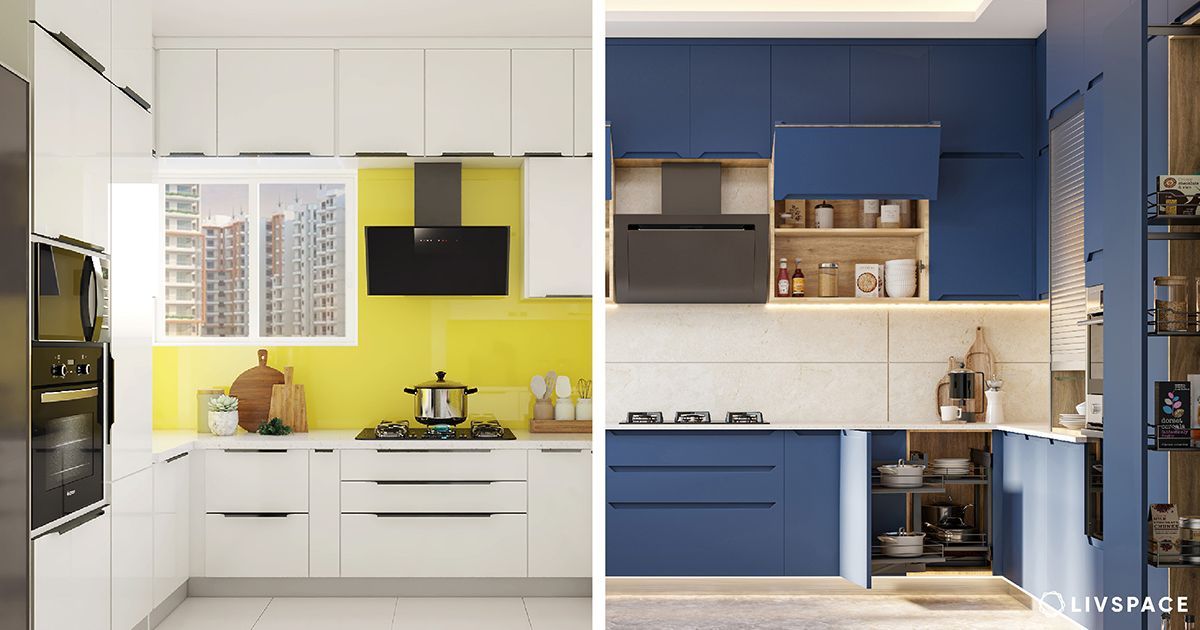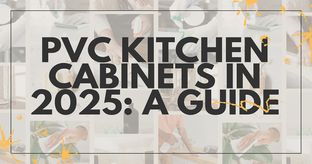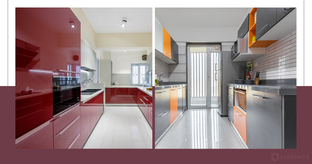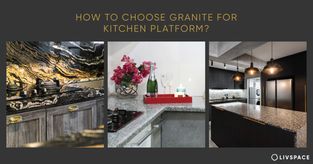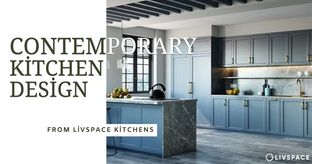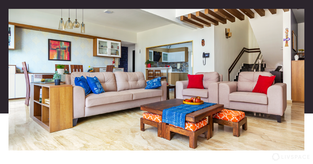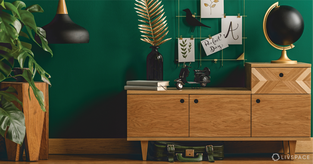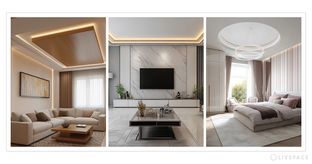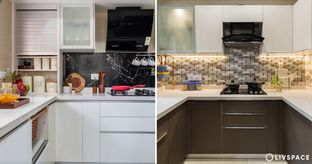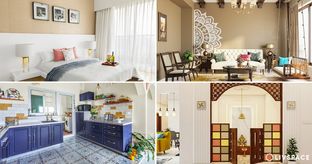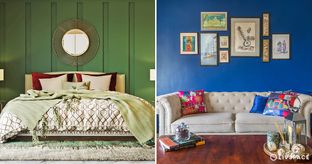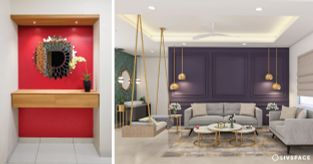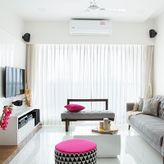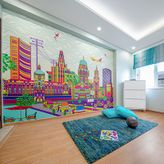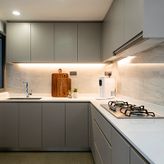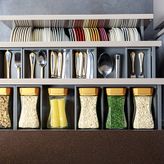In This Article
- How to identify a poor-quality kitchen?
- Why choose a Livspace kitchen?
- A quick overview of modular kitchen materials list
- What is each module made of?
- What are the different kitchen cabinet materials?
- What are the different kitchen cabinet materials finishes?
- Which material is best for kitchen cabinets?
- How can Livspace help you?
The kitchen, often the heart of a home, can turn into a daily horror if poorly designed with subpar materials. Imagine a space stifling your culinary joy and compromising safety. Quality kitchen cabinet materials are the unsung heroes, holding the power to transform a mundane kitchen into a functional and delightful space. In this blog, we cover everything in the modular kitchen materials list and reveal why choosing Livspace is your ticket to a cooking sanctuary. So what are you waiting for? Let’s explore the best materials for kitchen cabinets and more!
How to identify a poor-quality kitchen?
- Moisture leaking into the cabinetry
- The hinges are broken or faulty
- Peeling kitchen cabinet laminate
- Inadequate storage space
- The layout isn’t comfortable or functional
- The height and depth of the cabinetry isn’t ergonomic
Why choose a Livspace kitchen?
Typically, homeowners allocate a considerable portion of their interior design budget to the kitchen. Hence, it becomes vital to secure this investment by opting for top-tier kitchen cabinet materials and designs. With a Livspace kitchen, you shield yourself from the haunting repercussions of inferior core materials and finishes. Here are all the reasons that set Livspace kitchens apart:
- AquaBloc Technology – Repels moisture from entering the core
- DuraBuild Cabinets – Have a robust, sturdy build
- AntiBubble Technology – For smooth and bubble-free panels
- Precision Engineered Manufacturing – With an automated process for error-free designs
- Flat 10-Year Warranty* – On all kitchens
At Livspace, we offer MDF, HDF-HMR and ply kitchen cabinets. As for finishes, we offer kitchen cabinet laminate, acrylic, membrane, PU paint, veneer and glass.
Now, let’s deep dive into modular kitchens, components, cabinet materials and finishes.
A quick overview of modular kitchen materials list
Everyone wants a modular kitchen to simplify their cooking experience. However, how much do we know about these kitchens? Unlike traditional kitchens, they are made by assembling different modules to fit the size and utility of the space. Thus, these can be manufactured at a factory and then assembled at home.
What is each module made of?
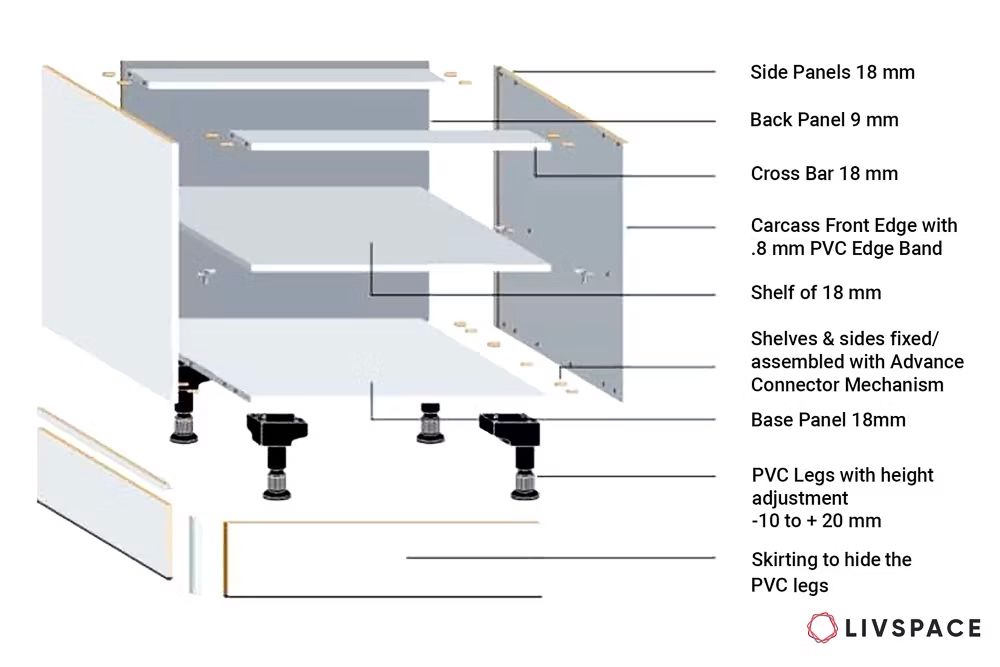
Let’s dive into the modular kitchen materials list. A carcass is the body of the module in which the top, bottom, back and side panels are joined. We add shutters, hardware and hinges to this carcass. The base modules for the kitchen come with PVC legs whose height you can adjust. There is a skirting added to these base modules to hide the legs.
Now that we have broken down the parts of a cabinet, let’s look at the list of common modular kitchen cabinet materials.
What are the different kitchen cabinet materials?
Wondering which material is best for kitchen cabinets? There are plenty of options that you can choose from for your modular kitchen, depending on their durability, budget, and lifestyle. While we at Livspace swear by HDF-HMR, MDF and plywood (you will see why below), let’s give you an overview of the modular kitchen materials list you can choose from:
| Material | Durability | Cost |
|---|---|---|
| Solid Wood | Moderate | High |
| Plywood | High | High |
| MDF | Moderate | Low |
| HDF-HMR | High | Moderate |
| Particle Board | Low | Low |
| Stainless Steel | High | High |
Kitchen cabinet material #1: MDF
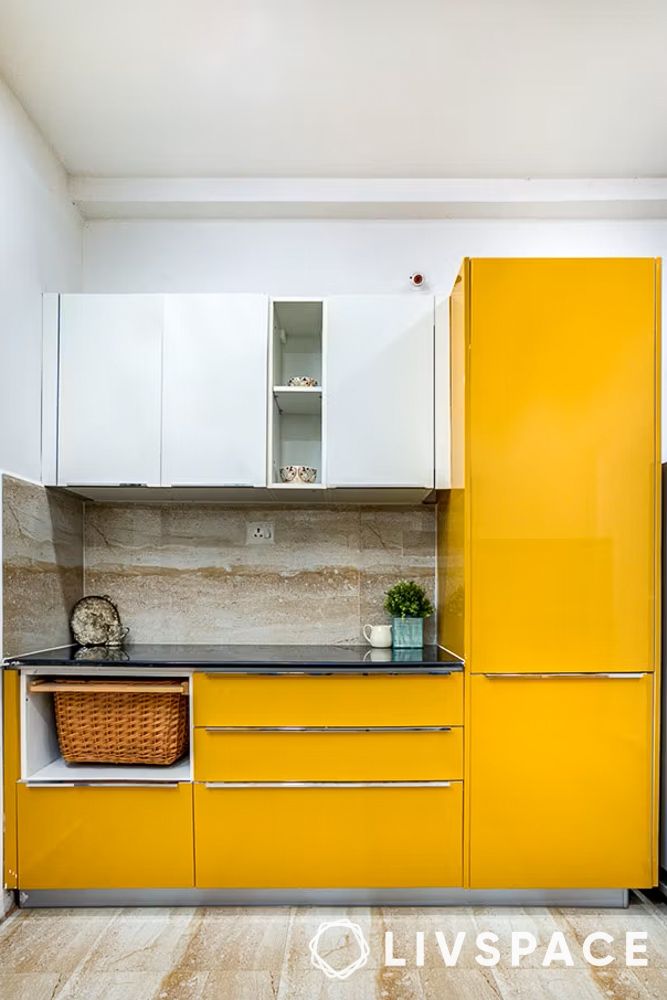
So, which material is best for kitchen cabinets when you are on a budget? The answer is MDF or Medium-Density Fibreboard.
A Medium-Density Fibreboard is made of small wooden fibres that are glued together with resins and hot-pressed. This is a budget-friendly kitchen cabinet materials option and can have any finish fitted on top.
Since this is an engineered wood, it has a smooth finish. In fact, it is better than wood because it doesn’t have knots or blemishes. It is also a homogenous material, and hence it is capable of having grooves or profiles. That makes it an ideal choice if you would like to opt for a traditional kitchen appearance.
Price of MDF kitchens
| Range | Finish | Unit | Price/sq.ft. without hardware | Price/sq.ft. with hardware |
| Essential range MDF | Matte laminate finish | Base unit | ₹2,343 | ₹2,870 |
| Glossy laminate finish | Base unit | ₹2,413 | ₹2,941 | |
| Premium range MDF | Matte laminate finish | Base unit | ₹2,681 | ₹3,230 |
| Glossy laminate finish | Base unit | ₹2,749 | ₹3,299 | |
| Luxury range MDF | Matte laminate finish | Base unit | ₹3.599 | ₹2,574 |
| Glossy laminate finish | Base unit | ₹3,668 | ₹2,643 |
We must also add that the MDF we use at Livspace can withstand moisture, thanks to our AquaBloc technology! As is the norm, MDF is used for all kitchen cabinets except for below-the-sink units and countertops.
A high-end MDF panel is sturdier and smoother than plywood or solid wood. Coupled with its affordability, it’s a great choice for kitchen cabinets.
Kitchen cupboard materials #2: HDF-HMR
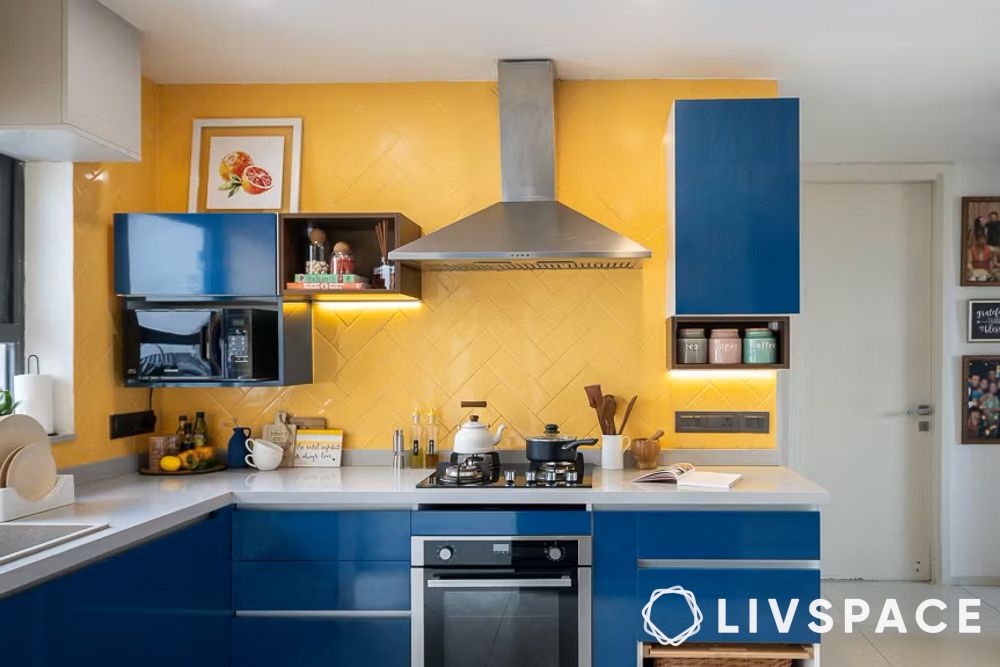
HDF-HMR might be costlier than MDF, but it has an even higher resistance to moisture. In fact, HDF-HMR or High-Density Fibreboard High moisture resistance is mainly used in high-water intensity areas like the kitchen and the bathroom.
This kitchen cabinet material is stronger and denser than all other alternatives like MDF, wood or plywood. Plus, HDF-HMR ensures a screw-holding capacity of up to 10 times more than plywood.
Price of HDF-HMR
| Range | Finish | Unit | Price/sq.ft without hardware | Price/sq.ft with hardware |
| Essential | Matte | Base unit | ₹2,759 | ₹3,286 |
| Glossy | Base unit | ₹2,836 | ₹3,363 | |
| Premium | Matte | Base unit | ₹3,183 | ₹3,733 |
| Glossy | Base unit | ₹3,259 | ₹3,808 | |
| Luxury | Matte | Base unit | ₹4,052 | ₹3,027 |
| Glossy | Base unit | ₹4,129 | ₹3,098 |
Most homeowners prefer to use a combination of MDF and HDF-HMR for the best results in terms of quality as well as durability. In such cases, the carcass is usually made of HDF-HMR while the shutters are made of MDF.
At Livspace, we ensure that the back panels of all our modular products (kitchen, wardrobe and storage) are made of HDF-HMR (5.5 mm thickness). That’s because the back panel is the closest to the wall and thereby is the most vulnerable to moisture. High-density fibreboard, being moisture-resistant, ensures that the overall unit lasts for a long time.
Kitchen cabinet material #3: Plywood
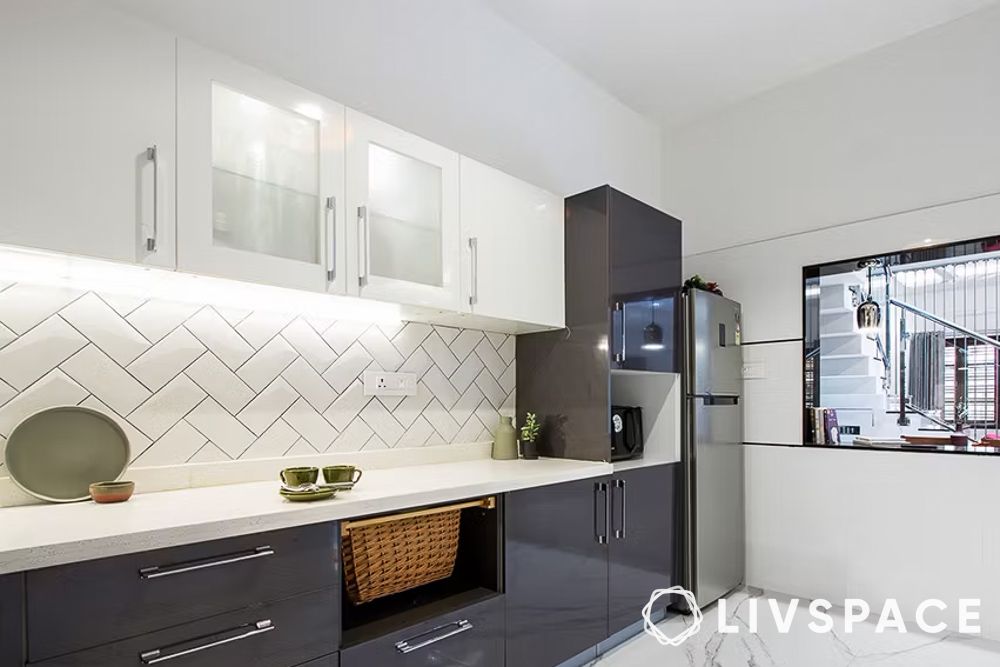
Plywood is an engineered wood made from sheets of veneer stacked perpendicularly on top of each other. Though on the slightly expensive side, this has been one of the most preferred kitchen cupboard materials due to its strength. If you are keen on going with plywood kitchen cabinets, you might be interested to know the three plywood variants:
- Livspace HydraTUF Plus ply – previously BWR ply
- Livspace HydraTUF Max ply- previously BWP ply
- Livspace HydraTUF ply – previously MR Ply
While HydraTUF Plus ply can resist moisture for up to 8 hours, HydraTUF Max Ply can stay moisture-resistant for up to 72 hours. You can opt for plywood kitchen cabinets if you stay in a place that gets flooded often.
If you don’t, you can just use plywood for the areas that see a lot of moisture like below the kitchen sink units, or countertops. As ply kitchen cabinets are heavier, it is never recommended for use in shutters. That’s because the heavier the weight, the more the chances of the shutters getting dislodged.
It is not possible to carve or add grooves on plywood. When you finish a plywood with laminate or acrylic, the undulations are retained and your cabinets may not get a smooth appearance.
Price of plywood kitchen cabinets
| Range | Finish | Unit | Price/sq.ft. without hardware | Price/sq.ft. with hardware |
| Essential MR Plywood | Matte | Base unit | ₹2,800 | ₹3,328 |
| Glossy | Base unit | ₹2,337 | ₹2,864 | |
| Essential BWR Plywood | Matte | Base unit | ₹3,220 | ₹3,747 |
| Glossy | Base unit | ₹3,308 | ₹3,835 | |
| Essential BWP Plywood | Matte | Base unit | ₹3,430 | ₹3,921 |
| Glossy | Base unit | ₹3,518 | ₹4,046 | |
| Premium MR Plywood | Matte | Base unit | ₹3,289 | ₹3,838 |
| Glossy | Base unit | ₹3,365 | ₹3,915 | |
| Premium BWR Plywood | Matte | Base unit | ₹3,826 | ₹4,375 |
| Glossy | Base unit | ₹3,913 | ₹4,462 | |
| Premium BWP Plywood | Matte | Base unit | ₹4,101 | ₹4,651 |
| Glossy | Base unit | ₹4,188 | ₹4,738 | |
| Luxury MR Plywood | Matte | Base unit | ₹4,140 | ₹3,114 |
| Glossy | Base unit | ₹4,217 | ₹3,253 | |
| Luxury BWR Plywood | Matte | Base unit | ₹4,619 | ₹3,594 |
| Glossy | Base unit | ₹,4803 | ₹3,861 | |
| Luxury BWP Plywood | Matte | Base unit | ₹4,861 | ₹3,253 |
| Glossy | Base unit | ₹4,949 | ₹3,924 |
Modular cabinet materials #4: Solid wood
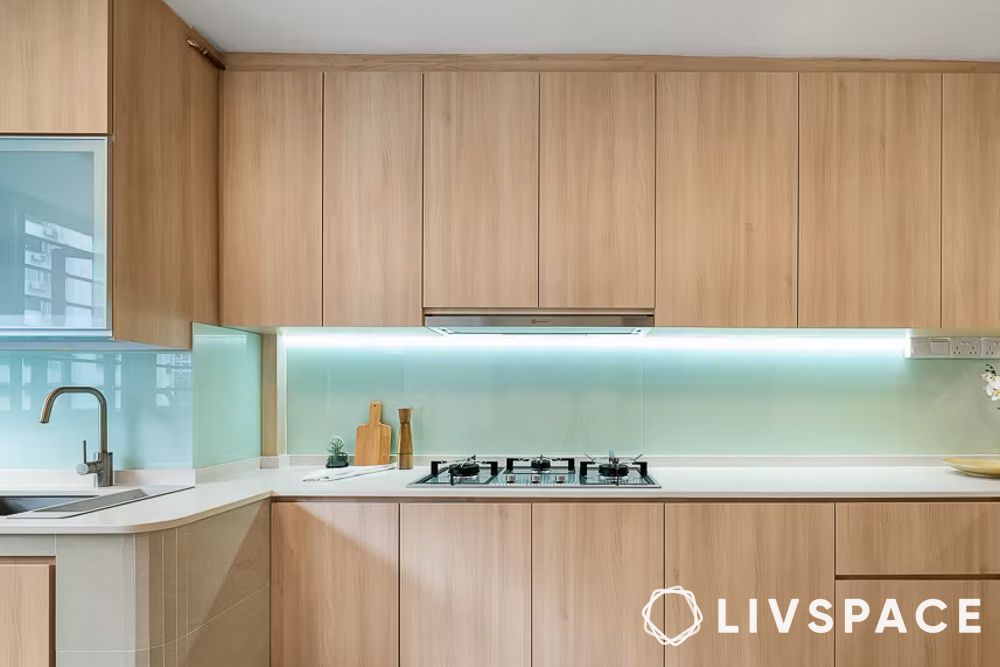
While traditionally used for kitchens, solid wood is no longer recommended by interior design experts to form the base of your modular kitchen. That’s because exposure to moisture can make kitchen cupboards made of wood swell or warp over time.
Want to know the advantages of kitchen cupboards made of wood? Well, they are sturdy and have a solid build when you can ensure that they stay miles away from water. Plus, each wooden grain is unique, so they can make your kitchen look amazing. However, these reasons aren’t good enough to build a kitchen that can swell or warp in humid weather conditions or on prolonged exposure to water.
Kitchen cabinet materials #5: Particle board
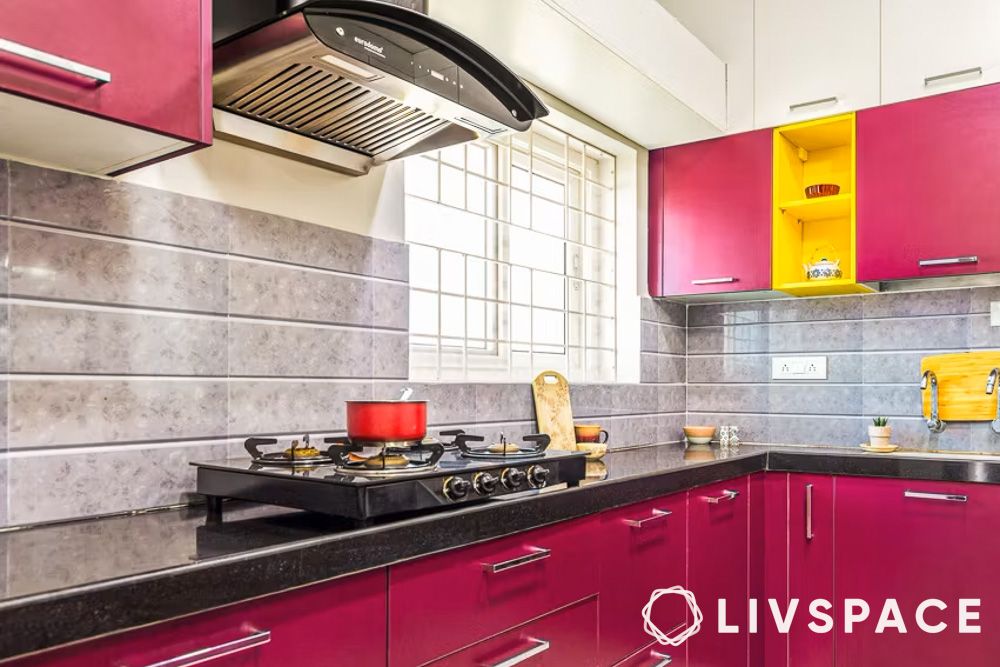
The cheapest material available in the market—particle board—is made from sawdust and waste wood, which is one reason why people question its quality. Since this kitchen cabinet material is not very sturdy, it cannot hold more weight.
Hence, you should ideally only use it to make shutters if you have budget constraints. However, we recommend that you always opt for superior materials like HDF-HMR or MDF.
Cabinet material for kitchen #6: PVC
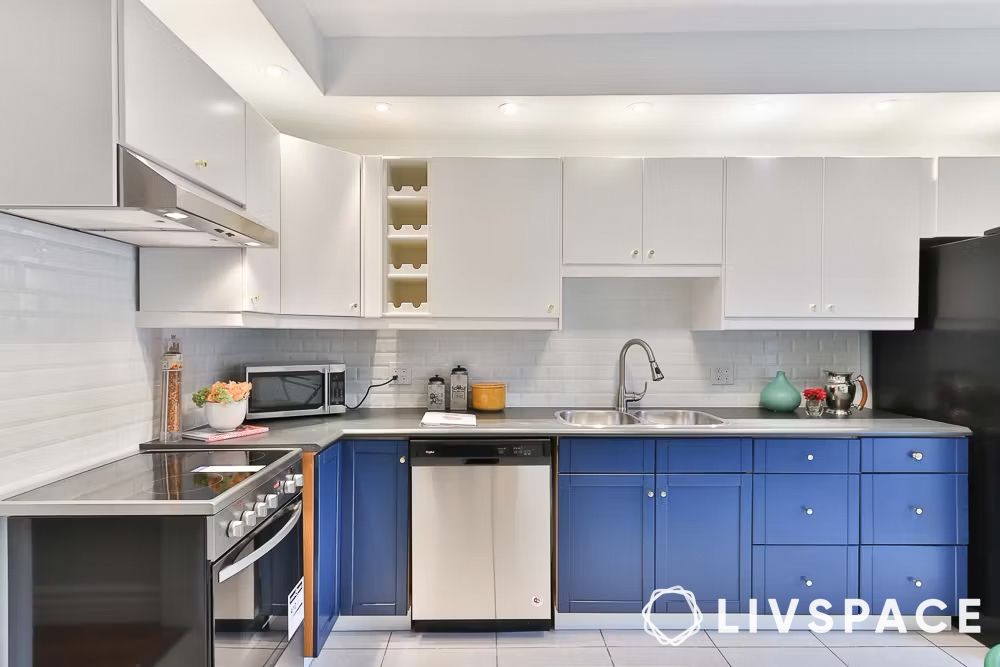
Another pocket-friendly kitchen cabinet material, PVC is easy to clean and maintain.
These days, PVC boards for kitchens are available as hollow boards and foam. While the former is heavier and sturdier, the latter is lighter and more economical.
The main advantages of PVC kitchens are that they are easy to repair and available in an array of colours.
Choose foam board as it is sturdier and can hold more weight in comparison to hollow PVC boards. However, PVC is not as durable as other materials and it is not recommended for use in a busy and humid area like a kitchen.
Also Read: All About PVC Kitchen Cabinets: A Comprehensive Guide With Pros and Cons
Latest modular cabinet materials #7: Stainless steel
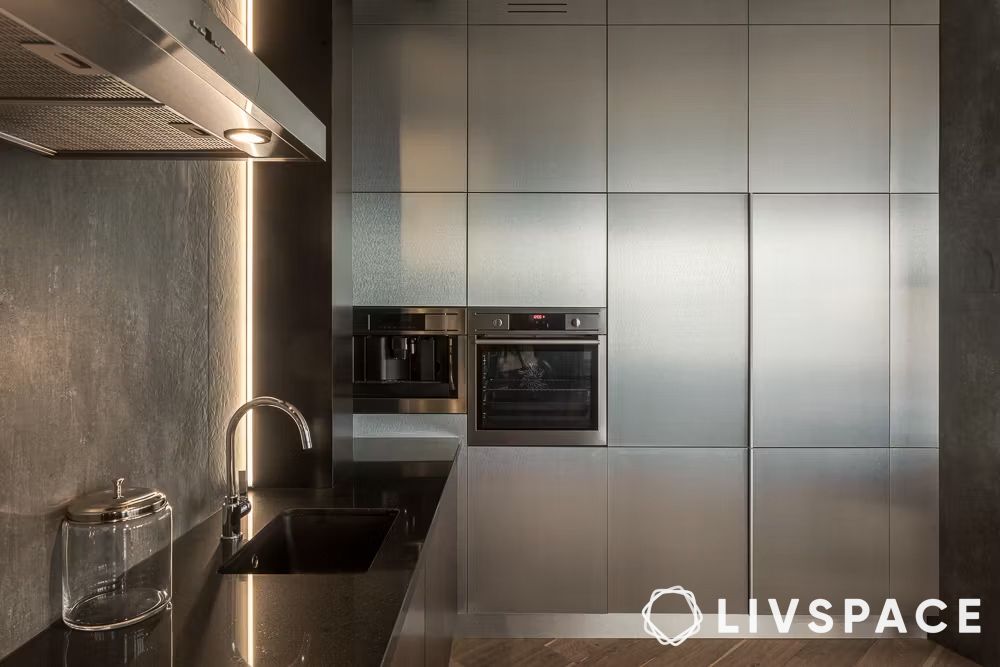
In the post-pandemic world, stainless steel is the latest material for kitchen cabinets slowly penetrating the Indian market. Stainless steel kitchen cabinets are durable, completely waterproof and easy to clean. Typically, stainless steel kitchen cabinets are used in commercial kitchens, as they are meant for heavy-duty use.
What are the different kitchen cabinet materials finishes?
While choosing the right kitchen cabinet material is crucial to building a durable kitchen, opting for the right kitchen finish can help you seal the deal. Let’s take a look at the different finishes available for modular kitchens:
| Finish | Maintenance | Cost |
|---|---|---|
| Laminate | Low | Low |
| Acrylic | Medium | Medium |
| Membrane | Medium | ₹1,855 to ₹3,472 |
| PU | High | ₹3,076 to ₹3,283 |
| Veneer | High | High (not provided by Livspace) |
| Glass | Medium | High |
Kitchen cabinet materials finish #1: Laminate
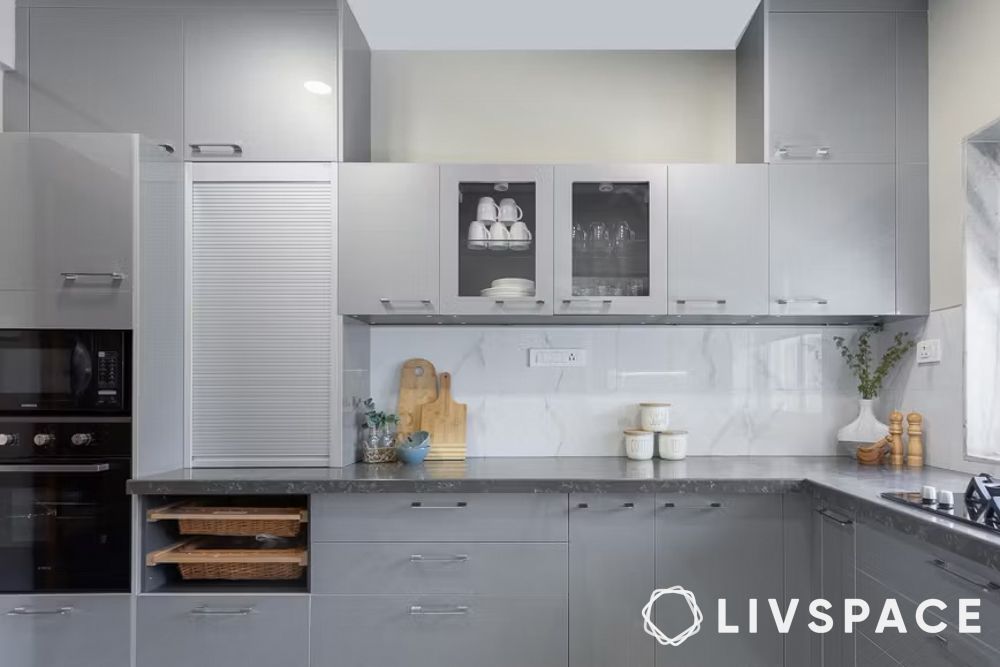
If you are looking for an enduring finish, kitchen cabinet laminates can come to your rescue. This finish is not only easy on the pocket but also moisture-resistant, making it the perfect match for a kitchen.
You can choose between matte, high gloss and textured kitchen cabinet laminates.
Price: ₹
Maintenance: Low
Usage: Kitchens, Wardrobes, Study Units, Vanity Units, TV Units, Pooja Areas
Kitchen cupboard materials finish #2: Acrylic
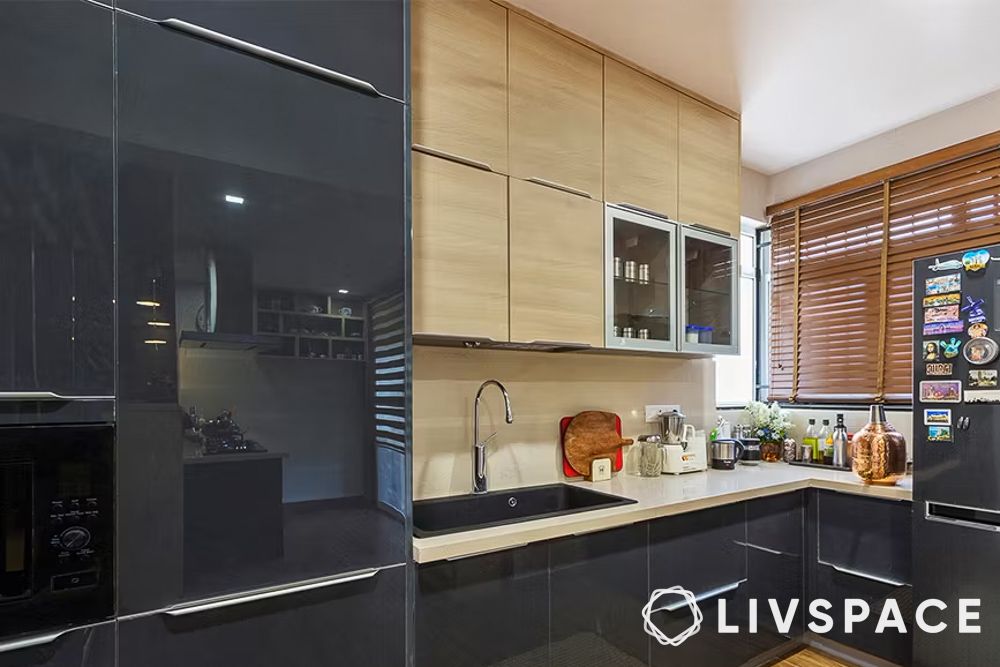
Want your kitchen to look stunning? An acrylic kitchen cabinet can give it a luxurious touch with its glossy finish. However, this means that fingerprints, dirt and stains can be more visible, and your kitchen cabinets will require regular cleaning. Also, this is an expensive variant in finishes.
The acrylic kitchen cabinet finish is a lightweight, scratch-resistant alternative to glass, with mirror-like reflective qualities.
Price: ₹₹₹
Maintenance: High
Usage: Kitchens, Wardrobes and Storage Units
Also Read: Acrylic or Laminate: Which is the Best Finish for Your Kitchen Cabinets?
Modular cabinet materials finish #3: Membrane
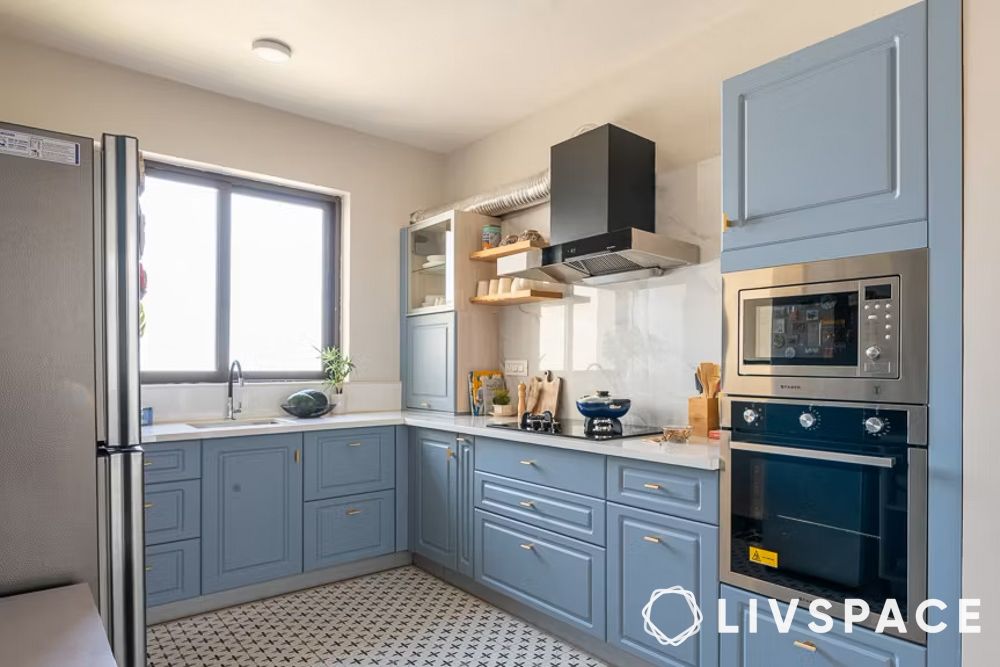
If you are looking for a mix of a durable yet elegant kitchen, the membrane finish is a good option. It is hard-wearing and relatively easy to maintain. Moreover, it is also easy to clean with a wet cloth and not as expensive as an acrylic finish.
The membrane is a highly mouldable finish that wraps around the core material with the help of high vacuum pressure. Due to this, it is ideal for panels that have grooves and designs.
Price: ₹₹₹
Maintenance: High
Usage: Traditional-looking Kitchens, Wardrobes and TV Units that have grooves
Kitchen cabinet materials finish #4: PU paint

Not happy with the above choices? Not to worry, we also offer PU finishes for that classy look. PU finish is basically painted over the shutter and can be glossy or matte.
It is a high-end sophisticated finish that is smooth, long-lasting and can push up the premium quotient of your home interiors instantly. PU also comes with grooves.
Price: ₹₹₹₹
Maintenance: High
Usage: Kitchens, Wardrobes and Storage Units
Kitchen cupboard materials finish #5: Veneer
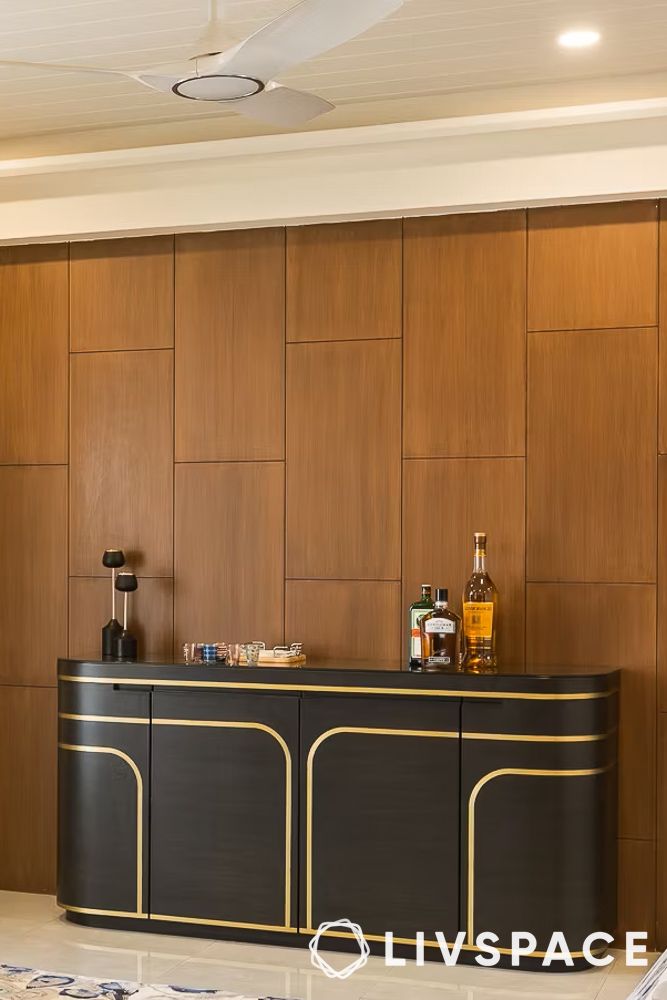
It is a thin layer of natural wood which is cold-pressed onto the surface of the core material using strong adhesives.
Every sheet of veneer has unique grains, which can help lend a striking look to your kitchen cabinets.
Price: ₹₹₹₹
Maintenance: High
Usage: Wardrobes and Storage Units
Modular cabinet materials finish #6: Glass
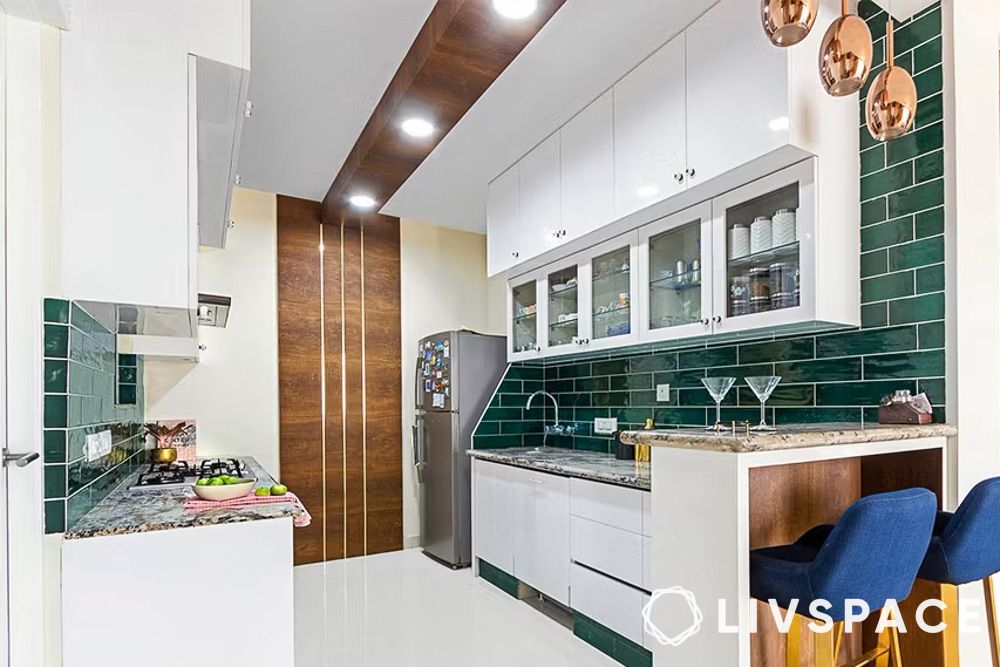
You can also opt for glass shutters in plain, fluted or frosted variants for a better view of your spices and groceries. This can make your kitchen look airy while making your cooking more effortless.
Price: ₹₹₹₹
Maintenance: Moderate
Usage: Wall Kitchen Cabinets
Also Read: A Master Guide To Kitchen Cabinet Finishes
Which material is best for kitchen cabinets?
Choosing the best materials for kitchen cabinets depends on your priorities. If you’re on a budget but still want durability, MDF is a great choice, especially with Livspace’s AquaBloc technology, which makes it moisture-resistant. However, for higher durability and moisture resistance, HDF-HMR is superior, making it ideal for areas with high water exposure. Plywood is another robust option, offering excellent strength, though it’s pricier. Each material has its strengths, so the best materials for kitchen cabinets depend on balancing cost, durability and specific kitchen needs.
How can Livspace help you?
- Our kitchens come with a flat 10-year warranty*
- All our modular products are precision-engineered in factories
- Plus, they are powered with superior technology such as AntiBubble, AquaBloc and DuraBuild that prevent air bubbles and moisture from damaging the product
If you want a beautiful kitchen for your home, then look no further. Book an online consultation with Livspace today.
*For full scope of warranty, please visit livspace.com/in/service.
Disclaimer: All contents of the story are specific to the time of publication. Mentions of costs, budget, materials, finishes, and products from the Livspace catalogue can vary with reference to current rates. Talk to our designer for more details on pricing and availability.
